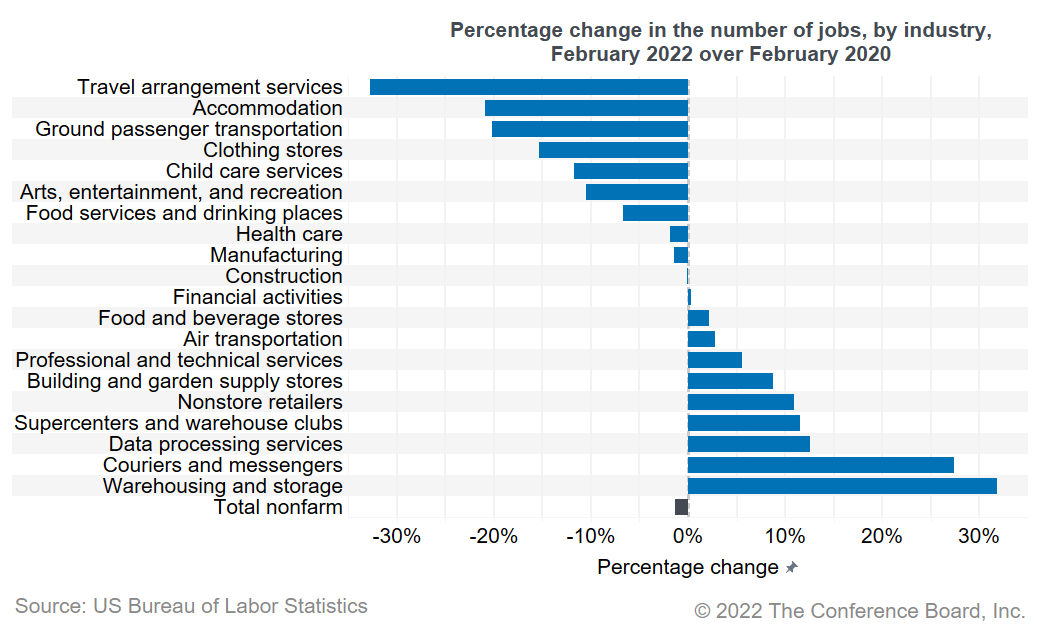-
Email
Linkedin
Facebook
Twitter
Copy Link

Loading...
Commentary on today’s U.S. Bureau of Labor Statistics Employment Situation Report Today’s jobs report showed strong job growth in February. While Omicron disruptions are now behind us, severe recruitment and retention difficulties persist. Wages continue to rise and this will put more pressure on already elevated price inflation. Nonfarm payroll employment increased by 678,000 in February, after an upwardly revised increase of 481,000 in January. The unemployment rate ticked down to 3.8 percent and the labor force participation rate increased slightly from 62.2 percent to 62.3 percent in February. Overall, jobs still number 2.1 million below prepandemic (February 2020) levels, representing a loss of 1.4 percent. For women, the job recovery has been slower with employment still 1.9 percent from prepandemic levels, compared to 0.9 percent for men. Job growth was again strong in leisure and hospitality, which added 179,000 jobs in February. Jobs were also added across most other industries, including 63,500 in health care and 60,000 in construction. Compared to February 2020, however, employment is still down 20.9 percent in accommodation and 6.7 percent in food services, signaling that many more jobs may be gained in these in-person services industries during 2022. Some jobs may not return, however, as job demand has shifted, especially to ecommerce related industries. After gaining about 1.2 million jobs in January and February combined, we expect about 3 million more jobs to be added in the remainder of the year. This will be lower than the 6.7 million jobs gained in 2021, but still higher than the 2.0 million in 2019. Slower job growth is expected as the economy is decelerating towards its long-run growth rate and more industries have already recovered. On top of that, recruitment difficulties are hampering job growth. The unemployment rate is expected to get close to 3 percent by the end of the year. Average hourly earnings rose 5.1 percent over the past 12 months, and in leisure and hospitality even by 11.2 percent. At the same time, rising inflation is eating into these wage gains. We expect wage growth to remain elevated as labor shortages will persist going forward. The inflation outlook is less certain. The recent invasion of Ukraine by Russian forces may drive up highly volatile food and energy prices. On the other hand, easing supply-chain issues and the Fed’s plans to raise interest rates may somewhat offset rising inflation during 2022. This jobs report underscores that the labor market is healthy and continues to improve. As such, we expect that the Fed will start raising interest rates in March.
March Payrolls: The Calm Before the Tariff Storm
April 04, 2025
February Jobs Report Hints at Growing Uncertainty
March 07, 2025
Q4 ECI Wage Deceleration Slows
February 07, 2025
Stability Underneath January’s Noisy Jobs Report
February 07, 2025
Robust Job Gains Close 2024
January 10, 2025
November Job Gains Rebound from Disruptions
December 06, 2024
Charts
Wage inequality continues downward trend in quarter 2 of 2023
LEARN MORECharts
Recent hikes in quits rates indicate retention difficulties across all industries, but have nearly approached pre-pandemic levels
LEARN MORECharts
Decline in office and administrative support work suggests certain tasks and skills have been replaced by automation
LEARN MORECharts
CEOs are having trouble filling positions as the unemployment rate drops lower
LEARN MORECharts
Non-union wages are growing faster than union wages
LEARN MORECharts
This index identifies the risk of future labor shortages for specific occupations.
LEARN MORECharts
Labor shortages and the tightening of labor markets have led companies to lower education requirements when recruiting.
LEARN MORECharts
The rapid rise in job openings to historic highs coupled with increasingly more workers quitting is leading to severe labor shortages, especially in leisure & hospita…
LEARN MORECharts
There has been a large increase in the share of office job ads that mention remote work since before the pandemic.
LEARN MOREPRESS RELEASE
Why the World Is Running Out of Workers
August 13, 2024
PRESS RELEASE
Report: As US Economy Grapples with Nearly 11 Million Unfilled Jobs, Immigr…
March 21, 2023
PRESS RELEASE
Difficulty Finding and Retaining Office Workers Skyrockets
May 05, 2022
PRESS RELEASE
CED Report Outlines Ways to Tackle Ongoing Labor Shortages
April 20, 2022
PRESS RELEASE
Tepid Job Gains Highlight Hiring Difficulties
June 04, 2021
PRESS RELEASE
Report: As COVID-19 Recedes, Labor Shortages Return as a Key Challenge for …
May 28, 2021
